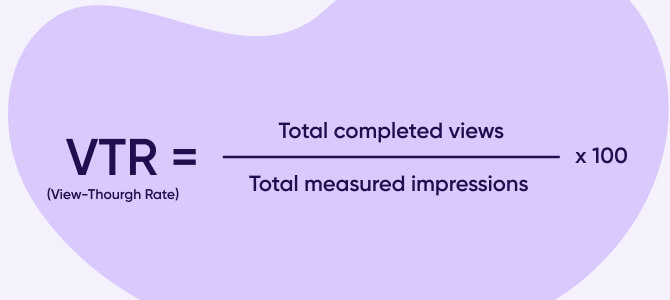
View through rate (VTR)
The view-through rate (VTR) measures the percentage of individuals who watched a video ad to the end, allowing marketers to track their ad’s effectiveness.
What is View Through Rate (VTR)?
Placing video ads on streaming platforms like YouTube and Hulu is a popular way of capturing viewers’ attention and promoting products or services. The view-through rate (VTR) measures these ads’ effectiveness by tracking the percentage of people who watched the ad from start to end.
Typical performance tracking metrics for video ads include views and impressions (or the number of people exposed to the video). However, these numbers don’t show how much of your ad people are watching or if they actually reached the end and saw your call-to-action (CTA).
For a complete understanding of a video ad’s effectiveness, you also need to track the VTR, which divides how many viewers watched the entire video ad by the total number of impressions.
This percentage can show an ad’s effectiveness, give insights into drop-off rates, and help to inspire new and better ads.
How does VTR work?
The VTR typically only applies to skippable ads.
Unskippable ads naturally have a VTR much closer to 100% since viewers must watch them to continue with their regular content.
The only thing that might lower the VTR on unskippable ads is if viewers stop watching the original video. But even then, the VTR is deceivingly high. You can still track VTR on unskippable ads, but it won’t show the ads’ effectiveness as it does for ads that viewers choose to watch or skip.
If you launch skippable video ads, the VTR can provide necessary insights about viewers’ initial thoughts. For example, a low VTR could indicate that the video didn’t capture the audience’s attention enough for them to keep watching.
That said, the VTR alone doesn’t always show the full picture. If a viewer clicks through to your site before finishing the entire video ad, their view won’t count toward the VTR, even though your ad did its job.
To counteract this and get a more comprehensive look at your ad’s effectiveness, you can measure VTR for portions of your video. For example, you can look at the VTR for 25%, 50%, and 75% of your ad to discover when people are choosing to skip the video.
If most viewers click out before they reach the CTA, you might need to make the content more engaging or move the CTA earlier.
All this tracking is possible thanks to a code embedded in the ad’s video player that measures how far into each ad a viewer watches. You can also add other codes known as “cookies” to track viewer behavior after the ad is complete — and see if they visit your brand’s website.
View through rate formula
To calculate VTR, use the following formula:
VTR = (Total completed views / Total measured impressions) x 100

Let’s say a video ad appears on 1,000 viewers’ screens — whether on streaming platforms or social media — and only 10 viewers watch the entire video. There are 10 completed views out of the 1,000 impressions, or the number of viewers exposed to the video content. If you put the data into the formula, it would be as follows:
- VTR = (10)/(1000) x 100
- VTR = 0.01 x 100
- VTR = 1%
Benchmarks: How to improve your VTR
Does a higher VTR mean a more successful video ad? Not necessarily. A VTR of 15% generally equals a successful video ad, but not everyone should aim that high.
Consider the end goal of your video ad and the product or service you are promoting. For instance, a low VTR may still be good for a video used to advertise a high-price item, because just a few sales can make the cost of producing the video worthwhile.
Before creating a plan to improve your VTR, consider these other factors that may impact it:
- Where a video advertisement appears (on which platforms and videos)
- The targeted viewers’ demographics
- The video’s title and thumbnail
- The video’s style, tone, and subject
- The video’s length
How to improve your VTR
One method for improving your VTR is to rethink where your ad appears. A low VTR could indicate that the current video audience does not resonate with your content. You can run demographic studies to identify your target audience and show your video ad to viewers who are more likely to resonate with your content.
Additionally, videos longer than two minutes are much more likely to have a shorter VTR, as viewers get distracted or disinterested during a longer video. In fact, shorter videos often perform better than longer ones. Consider keeping your ads to less than a minute, or even less than 30 seconds.
Research suggests that brands have just eight seconds to capture viewers’ attention. If a viewer doesn’t see or hear something that piques their interest in the first eight seconds of a video, they are more likely to click away.
Not only do the first ten seconds need to be interesting, but they also need to be high-quality. A low-quality video or one that loads slowly may cause viewers to lose interest, lowering the video’s VTR.
What is the difference between VTR and VCR?
Video completion rate (VCR) is the percentage of viewers who watch a video to the end or to a predetermined point.
Both VTR and VCR track the same metric, and brands can use them interchangeably. Nevertheless, to avoid confusion — it’s a good idea to choose either VTR or VCR and stick with your chosen term for measuring views.
What about VTR and CTR?

Click-through rate (CTR) is the percentage of people who click on an ad, video, email, or link — out of everyone exposed to it.
While VTR measures completed video views, it does not track the effectiveness of a video ad beyond that, whereas CTR shows how many people went from the video to your landing page or website.
Because they measure different metrics, you can use VTR and CTR together to measure a video advertisement’s overall effectiveness. For example, if the VTR is low while the CTR is high, then the ad is successful. However, if an ad has a high VTR coupled with a low CTR, the video might not be as successful at driving sales.
Key takeaways
- View-through rate (VTR) measures the number of viewers who watched an entire video ad divided by the number of impressions, or people exposed to the video. Multiply that number by 100 to get the VTR as a percentage.
- Code embedded into the video allows businesses to measure the number of views a video has and at what point viewers click away.
- A good VTR varies based on several factors, including the length of the video, where it appears, its style, and its tone.
- You can use VTR and VCR interchangeably to track a video’s effectiveness based on how many people viewed the entire ad.
- VTR and CTR both measure a video advertisement’s performance. However, CTR measures the percentage of viewers who clicked through to the company’s website or landing page after seeing the ad.




